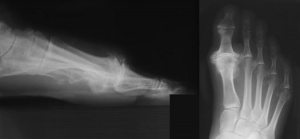Big Toe Joint Osteoarthritis(Hallux Rigidus)

Hallux rigidus is a term used to describe a painful stiff great toe as a result of osteoarthritis. Osteoarthritis of the great toe can be graded depending on the severity of the symptoms suffered by the patient, the restriction in movement, and the radiological findings.
The treatment for hallux rigidus depends on the stage of the disease.
Grade 1 represents the mildest form. Patients suffer intermittent pain in the great toe with no significant reduction in movement. The x-rays should show a well preserved joint space although a true lateral view may reveal a small dorsal osteophyte.
The treatment for this stage of the disease usually consists of activity modification, orthotics and anti-inflammatories.
Grade 2 of the disease represents a progression of the arthritis. Patients complain of more constant pain in the great toe. There is a reduction in movement and the x-rays show some loss of the joint space.
The treatment for this stage stage of the disease if conservative measures fail is to undertake a cheilectomy (a surgical debridement of the joint) and removal of the osteophyte.
n Grade 3 of the disease there is marked stiffness in the great toe and x-rays reveal a complete loss of the joint space.
There are a number of surgical options to treat this grade of disease. These include a fusion of the great toe MTP joint, an excisional arthroplasty, and a great toe replacement. A fusion still remains one of the most reliable ways of improving pain and function in Grade 3 disease. There remain questions about the long time survivor ship of great toe replacements.